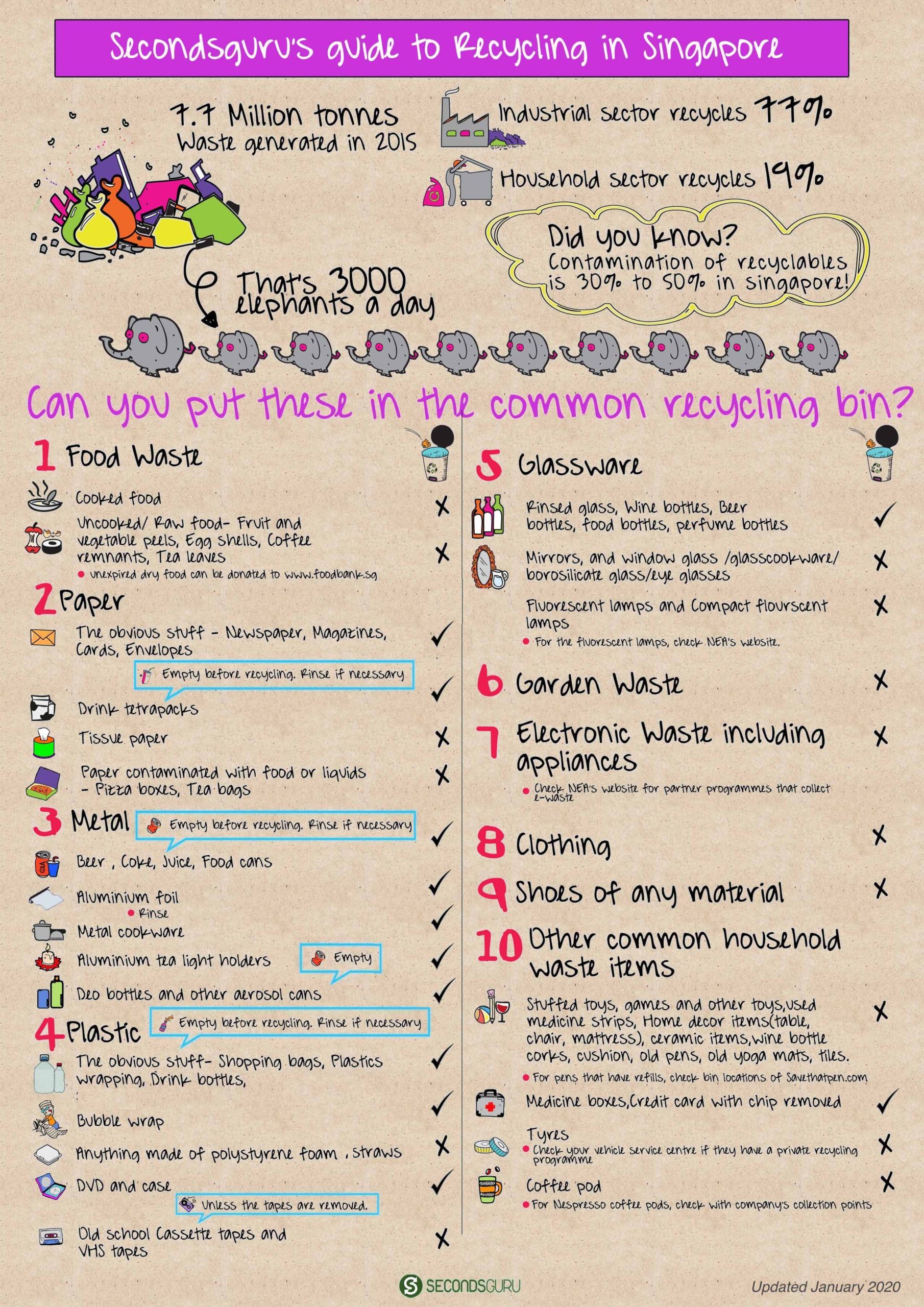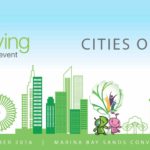Published 28 August 2016 ● Last Updated on 1 October 2020
As a family we try our best to be environmentally conscientious and create as less waste as we can. Moreover the waste we generate is diligently sorted on a day-on-day basis and divided between the recycling bin [we have a designated bin at home] and the rubbish bin [which eventually goes down the chute]. So I was rather disappointed when I found out about the abysmally low levels of domestic recycling and the rampant contamination of domestic waste in Singapore. And that’s what set me thinking that perhaps it is the lack of awareness rather than malicious intent that is the root cause of it all. In order to address this issue, we at Team Secondsguru decided to put together a list of common household waste items and the best way to dispose them off [refer our infographic below].
Honestly, here in Singapore we do not really have a choice. As a nation, we are required by law meet certain environment standards under the Paris Agreement and recycling consciously is one of them. So what is the Paris Agreement? It is the first time that countries in various stages of development have signed a legally binding global climate pact- primarily to 1) restrict the global temperature increase to below 2 degree centigrade 2) contain global green house emissions to respectable levels. Why is it relevant for us? Well, because in December 2015, Singapore was one of the 194 countries that signed this agreement.
What does this really mean at the ground level for Singapore as a nation and all of us living here?
- We need to reduce mindless consumption of energy resources
- Increase creation and usage of alternative energy sources
- Build more green buildings and homes
- Use public transport and switch to hybrid/electric cars
- Recycle mindfully in our factories, offices and most importantly our homes
For the purpose of this write up we will look at how we have fared as a nation in our recycling efforts using a Waste Recycling Report Card.
Topic: Total Waste and domestic recycling
Verdict: Room to improve
Of the 7.7 million tonnes of total waste generated in Singapore in 2015 [That is the weight of 3000 fully grown African male elephants per day by the way ]- the industrial sector recycled 77% , while the domestic household sector only recycled 19% (down from 22% in 2010). This stands in stark contrast to Taiwan where the household recycling rate is as high as 50%.
Add to this that fact that Singapore’s only landfill- The Semakau Landfill- is expected to be filled up by 2035 – a decade sooner than the original 2045 projection. Alarm bells are ringing and we will all bear the consequences if we do not act right away!
Topic: Total Waste and overall recycling
Verdict: Good
There is a silver lining on this count, of the 7.7 mil tonnes of total waste, the overall recycling rate was 61% in 2015[up from 60% in 2014]. However worth noting is that the total waste generated in 2014 was 7.5 million tonnes. So we created 159,000 tonnes more of waste as a nation in 1 year- attributable to the growing population and ever increasing wealth on our island state.
Topic: Contamination of waste
Verdict: Poor
Did you know that more than 1/3rd of recyclables collected from households in Singapore are contaminated? Used diapers, used tissue papers, toxic components of electronic waste and food waste are the prevalent perpetrators. Hence, next time you are done partaking the yummy home delivered pizza, please do not put the cardboard box in the recycling bin- you will save yourself from doing a huge disservice to the nation. If the food you ate was however in a plastic container, you can rinse and put it in the common recyling bin. Never without rinsing though!
According to the National Environment Agency, NEA, the contamination across all four public waste collectors – SembWaste, Veolia, Colex and 800 Super – is between 30% and 50%. That means
1. More work for the recyclers as well as perfectly good recycling material going to waste because it was affected by the contaminating [and un-recyclable] item.
2. It also translates to potential health hazards for the workers at the sorting plants particularly from the electronic waste.
Want to know what happens to waste once it leaves your home? Here is a step-by-step guide by Straits Times correspondent, Rebecca Lynne Tan on the sorting and separation process.
So what can we do to improve the verdict on our Waste recycling report card?
Before we look into how to achieve it, we would like to highlight that the earlier mentioned high [50%] household recycling rate in Taiwan [up from 5% in 1997] is such because recycling is a way of life there and has been made into a law.
Do we think recycling needs to be made into an enforceable law in Singapore to get effective results? There are many views. At Secondsguru, we believe action taken out of free will will yield much better and sustainable results, hence we sat down with National Environment Agency [NEA], Singapore to put together an easy-to-use list of what can and can’t be put into the common recycling bin. If we simplify the recycling process we are hopeful that there will be quicker buy-in by the busy folks in our little red dot. In fact one quick-fix way to move towards being a more informed recycler would be to print a copy of this waste recycling list on a used paper and stick it up on the fridge- making it easy enough for all in the family to access.
Here’s a ready reckoner to help you decide whether to dump it – or recycle it. All ticked items can go in the recycle bin at your HDB/condo/house. Some crossed items can be recycled at special drop-off centres [indicated in footnotes on the infographic], though still not in your regular recycle bin. Two points here
1. Garden waste is not collected in the common recycling bin. Only landed estates are provided with garden waste collection services as these estates usually produce more garden waste. All grass and leaves should be collected in plastic bags and tied securely. Large branches which cannot be placed inside the plastic bag should be tied up in small bundles. The garden waste should be placed beside the bin (not in the bin) for collection.
2. If you have items like used clothes,shoes and stuff toys, games and other toys which are in good condition, do consider donating them to a charity of your choice in Singapore[ 7 places you can donate your pre-loved clothes, toys, books in Singapore]. If you really love any particular piece of clothing, you can choose to upcycle it too [How to upcycling your pre loved clothes without being a master seamstress?]

Come, let’s recycle responsibly.
However, we should not just stop at recycling consciously, instead let’s try and do as much as we can, it’s never really enough!
– Drive less, walk / bike more
– Share the information and spread the word
– Volunteer for environmental events- Beach clean ups, park cleanups and the like
– Of course follow the 5 R’s- Refuse, Reduce, Reuse, Repair and Recycle
– Save water
– Consume sustainably – What you eat, what you wear, anything you use basically!
– Shop consciously- Only what you need and take a bag along!
– Green up your home and surrounding areas- Grow your own herbs, and have greens around you, remember they give us the oxygen we need
– Last but not the least, use the NEA app it’s fantastic! For more information and to find the closest recycling bin or station, download the myENV mobile app, available on the Apple and Google Play stores.
Main Sources: NEA, Straits Times
Related Article:
Moving towards a Zero waste home in Singapore



0 Comments